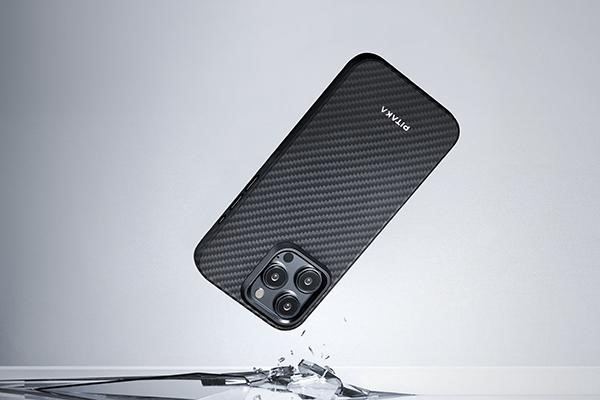What Makes Phone Cases Protective?
We all know the feeling: that heart-stopping moment when your phone slips from your hand and you pray it doesn’t hit the ground too hard. Whether it’s a minor tumble from the table or a major drop onto the pavement, our phones are constantly at risk of getting damaged. That’s where phone cases like PITAKA come in. But have you ever wondered what makes phone cases protective in the first place?
From materials to design, not all phone cases offer the same level of protection. Some are built like tanks, while others are more about aesthetics. In this article, we’ll break down what actually makes a phone case protective, so you can better understand what to look for when choosing the best case for your device.
Materials Matter: What Are Phone Cases Made Of?
The material used in a phone case plays a huge role in how much protection it offers. Different materials provide varying levels of durability, impact resistance, and flexibility. Here are some of the most common materials and how they contribute to keeping your phone safe:
- Silicone and Rubber
Silicone and rubber are popular materials for phone cases because they’re soft, flexible, and great at absorbing shock. When your phone hits the ground, these materials help to cushion the impact and distribute the force, reducing the chance of your phone screen cracking or the body getting dented.
Rubberized cases also tend to have a better grip, which means they’re less likely to slip out of your hand in the first place. Plus, they’re water-resistant, offering an extra layer of protection if your phone gets splashed.
- Plastic (Polycarbonate and TPU)
Plastic is another go-to material for protective phone cases, especially polycarbonate and TPU (thermoplastic polyurethane). Polycarbonate is a hard plastic that’s known for being tough and durable. It’s often used in rugged or military-grade cases because it can withstand significant impacts and prevent scratches.
TPU, on the other hand, is a bit softer and more flexible, but still offers excellent protection. TPU cases often combine the flexibility of silicone with the durability of hard plastic, giving you the best of both worlds.
- Leather
Leather cases aren’t just about style—they can also offer decent protection. While leather isn’t as shock-absorbent as silicone or polycarbonate, it’s still durable and can protect your phone from scratches and minor drops. Leather cases also tend to age beautifully, gaining a patina that adds character over time. They offer a good balance between fashion and function, but if you’re prone to dropping your phone from great heights, leather alone might not be enough.
- Aramid Fiber
For those looking for ultra-slim cases that still offer protection, aramid fiber is a material worth considering. It’s used in cases like PITAKA, which are known for their lightweight, slim design while still being strong. Aramid fiber is a high-tech material also used in aerospace and military applications, so it offers protection without the bulk of traditional cases.
Key Features That Add Protection
Beyond the materials, there are several design elements and features that can make a phone case more protective. Here’s what you should look out for when trying to find a case that will truly keep your phone safe.
- Shock Absorption
When your phone drops, the impact needs to go somewhere. Cases with good shock absorption are designed to take the brunt of the fall. Look for cases that advertise “shock-absorbing” or “impact-resistant” features. These cases are often thicker around the edges or have a layer of padding designed to absorb the force of the drop, which helps keep your phone’s internal components safe.
- Raised Edges
Also known as “bezels,” raised edges are a crucial feature that can prevent your screen or camera from shattering when dropped. These raised edges create a buffer between the surface your phone lands on and the delicate parts of your device. So if you drop your phone face down, the raised edges will lift the screen off the ground, reducing the chance of cracks.
The same goes for the camera lens—raised bezels around the camera can protect it from scratching or breaking, especially since modern phones, like the iPhone 16 Pro, have cameras that stick out a bit from the back.
- Drop Protection Ratings
You might have seen some cases advertising “military-grade” protection or drop protection ratings. This simply means that the case has been tested to withstand drops from certain heights, usually onto hard surfaces like concrete. For example, military-grade drop protection (MIL-STD-810G) means the case has passed rigorous testing for durability and impact resistance.
While not everyone needs a military-grade case, it’s nice to know that certain cases are built to handle more than just the occasional slip off the couch. If you’re particularly clumsy or use your phone in rugged environments, a case with a drop protection rating could give you peace of mind.
- Scratch Resistance
A good phone case doesn’t just protect your phone from drops—it should also prevent scratches. Look for cases made with scratch-resistant materials or coatings. Plastic, leather, and metal cases can get scratched over time, but some are designed to resist this wear and tear better than others. If you want your phone and its case to stay looking good over time, scratch resistance is a key feature to consider.
- Water Resistance
While not all phone cases are fully waterproof, some do offer water-resistant features. For example, some cases include port covers to keep water and dust from entering the phone’s charging or headphone ports. If you’re worried about accidental splashes or exposure to rain, a case with water-resistant properties can be a lifesaver.
For those who need serious waterproof protection, there are heavy-duty cases designed to make your phone fully waterproof for certain depths and durations. These are great for outdoor adventurers, beachgoers, or anyone prone to dropping their phone in water.
Why Thickness Isn’t Everything
It’s tempting to think that the thicker the case, the better the protection. And while bulkier cases do offer more padding and shock absorption, thickness isn’t the only factor that makes a case protective. In fact, some slim cases can offer just as much protection, depending on their material and design.
Take aramid fiber cases, for example. These ultra-thin cases are incredibly strong despite their lightweight profile. Brands like PITAKA have perfected the balance between slim design and durability, offering protection without turning your phone into a bulky brick. So, while thick cases might offer more of a cushion, don’t count out slim cases—just make sure they’re made from high-quality materials and include features like raised edges or shock absorption.
Choosing the Right Case for Your Needs
So, what makes a phone case protective? It’s a combination of material, design features, and how well it suits your lifestyle. If you’re someone who’s always on the go or prone to dropping your phone, a case with military-grade protection and shock-absorbing materials might be worth the investment. On the other hand, if you’re more careful with your device but still want some peace of mind, a slim case with raised edges and scratch resistance could be the perfect solution.
Ultimately, the best phone case is the one that offers the level of protection you need while fitting your style and comfort preferences. Whether you go for a rugged, heavy-duty case or a sleek, minimalist option, make sure your phone is protected from life’s little accidents.





